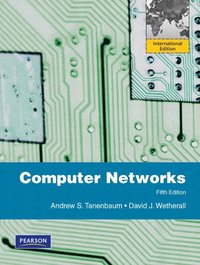
- Format
- Häftad (Paperback)
- Språk
- Engelska
- Antal sidor
- 951
- Utgivningsdatum
- 2010-11-30
- Upplaga
- 5
- Förlag
- PRENTICE-HALL
- Medarbetare
- Wetherall, David J.
- Illustratör/Fotograf
- Illustrations
- Illustrationer
- Illustrations
- Volymtitel
- International Version
- Dimensioner
- 232 x 177 x 52 mm
- Vikt
- Antal komponenter
- 1
- ISBN
- 9780132553179
- 1446 g
Computer Networks: Pearson International Edition 5th Revised Edition
International Version
Slutsåld
Kundrecensioner
Fler böcker av författarna
-
Modern Operating Systems, Global Edition
Andrew S Tanenbaum
-
Computer Networks, Global Edition
Andrew S Tanenbaum
-
Distributed Systems
Andrew S Tanenbaum, Maarten Van Steen
-
Modern Operating Systems
Andrew S Tanenbaum
Övrig information
Andrew S. Tanenbaum is a Professor of Computer Science at Vrije Universiteteit, Amsterdam, the Netherlands. He is a fellow of IEEE and ACM and a member of the Netherlands Royal Academy of Arts and Sciences. He recently won a prestigious European Research Council Advanced Grant of 2.5 million to do research on highly reliable computer systems. Tanenbaum has also authored or coauthored the following titles: Structured Computer Organization, Fifth Edition; Operating Systems: Design and Implementation, Third Edition; and Distributed Systems: Principles and Paradigms, Second Edition, all published by Prentice Hall. David J. Wetherall is an Associate Professor of Computer Science and Engineering at the University of Washington in Seattle. He hails from Australia and has worked in the area of networking for the past two decades. His research is focused on Internet protocols, wireless networks, and security. Wetherall's work has been recognized with a Sloan Fellowship, the IEEE Bennett Prize, and the ACM SIGCOMM Test-of-Time Award.
Innehållsförteckning
CHAPTER 1 INTRODUCTION
1.1 USES OF COMPUTER NETWORKS
1.1.1 Business Applications
1.1.2 Home Applications
1.1.3 Mobile Users
1.1.4 Social Issues
1.2 NETWORK HARDWARE
1.2.1 Personal Area Networks
1.2.2 Local Area Networks
1.2.3 Metropolitan Area Networks
+1.2.4 Wide Area Networks
1.2.5 Internetworks
1.3 NETWORK SOFTWARE
1.3.1 Protocol Hierarchies
1.3.2 Design Issues for the Layers
1.3.3 Connection-Oriented Versus Connectionless Service
1.3.4 Service Primitives
1.3.5 The Relationship of Services to Protocols
1.4 REFERENCE MODELS
1.4.1 The OSI Reference Model
1.4.2 The TCP/IP Reference Model
1.4.3 The Model Used in this Book
**1.4.4 A Comparison of the OSI and TCP/IP Reference Models
**1.4.5 A Critique of the OSI Model and Protocols
**1.4.6 A Critique of the TCP/IP Reference Model
1.5 EXAMPLE NETWORKS
+1.5.1 The Internet
+**1.5.2 Third-Generation Mobile Phone Networks
+**1.5.3 Wireless LANs: 802.11
++**1.5.4 RFID and Sensor Networks
**1.6 NETWORK STANDARDIZATION
**1.6.1 Who's Who in the Telecommunications World
**1.6.2 Who's Who in the International Standards World
**1.6.3 Who's Who in the Internet Standards World
1.7 METRIC UNITS
1.8 OUTLINE OF THE REST OF THE BOOK
1.9 SUMMARY
CHAPTER 2 THE PHYSICAL LAYER
2.1 THE THEORETICAL BASIS FOR DATA COMMUNICATION
2.1.1 Fourier Analysis
2.1.2 Bandwidth-Limited Signals
2.1.3 The Maximum Data Rate of a Channel
2.2 GUIDED TRANSMISSION MEDIA
2.2.1 Magnetic Media
2.2.2 Twisted Pairs
2.2.3 Coaxial Cable
++2.2.4 Power Lines
2.2.5 Fiber Optics
2.3 WIRELESS TRANSMISSION
+2.3.1 The Electromagnetic Spectrum
2.3.2 Radio Transmission
+2.3.3 Microwave Transmission
+**2.3.4 Infrared Transmission
+**2.3.5 Light Transmission
**2.4 COMMUNICATION SATELLITES
**2.4.1 Geostationary Satellites
**2.4.2 Medium-Earth Orbit Satellites
**2.4.3 Low-Earth Orbit Satellites
**2.4.4 Satellites Versus Fiber
2.5 DIGITAL MODULATION AND MULTIPLEXING
++2.5.1 Baseband Transmission
++2.5.2 Passband Transmission
+2.5.3 Frequency Division Multiplexing
2.5.4 Time Division Multiplexing
+2.5.5 Code Division Multiplexing
2.6 THE PUBLIC SWITCHED TELEPHONE NETWORK
2.6.1 Structure of the Telephone System
2.6.2 The Politics of Telephones
+2.6....
